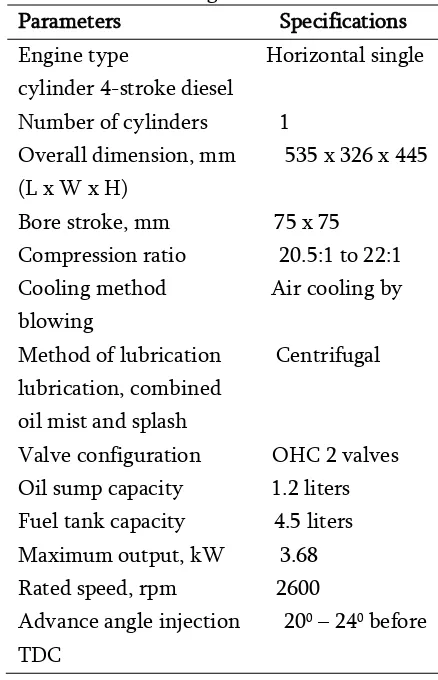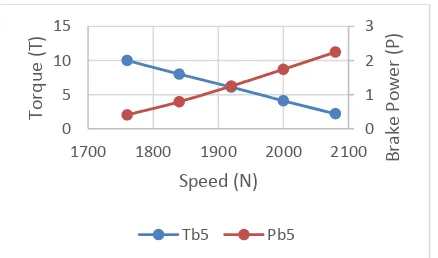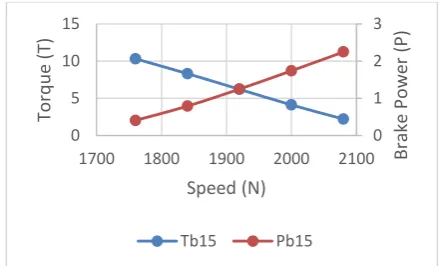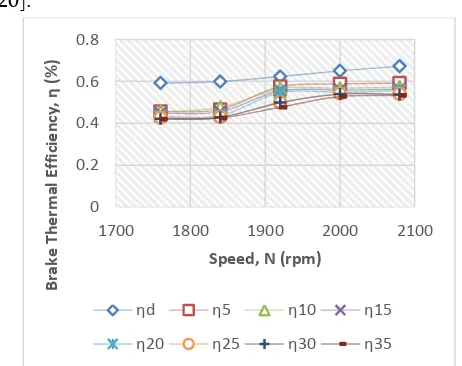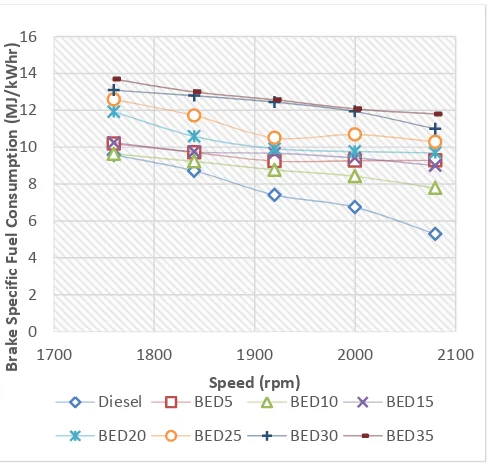IJSRSET1841317 | Received : 21 Feb 2018 | Accepted : 28 Feb 2018 | January-February-2018 [(4) 1 : 1439-1447 ]
© 2018 IJSRSET | Volume 4 | Issue 1 | Print ISSN: 2395-1990 | Online ISSN : 2394-4099 Themed Section : Engineering and Technology
1439
Performance Evaluation of Biodiesel-Ethanol-Diesel Blends as
Fuel in A Single Cylinder Diesel Engine
I. Yahuza1, H. Dandakouta1, D. Y. Dasin2, R. I. Ejilah3
1Department of Automobile Engineering, Abubakar Tafawa Balewa University Bauchi, Nigeria 2Department of Mechanical Engineering, Modibbo Adama University of Technology, Yola, Nigeria 3Department of Mechanical/Production Engineering, Abubakar Tafawa Balewa University Bauchi, Nigeria
ABSTRACT
In this research, the blends of ethanol and biodiesel with diesel in varying proportions were used. Performance parameters like torque, brake power, brake thermal efficiency and brake specific fuel consumption (BSFC) were studied. The results showed that the BED30 fuel gave the best performance in comparison with conventional diesel fuel. The tests were carried out on a horizontal single-cylinder, 4-stroke, air-cooled, 3.68 kW engine, TecQuipment TD115 MK-II model. The engine was coupled to a manometer (model: Z30EBIX25) and DG eddy current dynamometer (model: WB2.7 PB43) with rated power of 3.68 kW at 2600 rpm and was operated at a constant load of 1000 g. The test results showed that, with decreasing speed, the torque of the engine fueled with both diesel and the blends increased, and the maximum torque was recorded at 1760 rpm of engine speed, for all the fuel samples tested. The research reveals that for a constant load of 1000 g, brake power increases with the increase in engine speed, thus a maximum brake power of 2.4 kW was obtained at 2080 rpm for BED30, this confirmed the results reported by researchers. There was an increase in the engine’s brake thermal efficiency when run on diesel and all the fuel blends at all speed conditions. The BSFC of the blends varied depending on the engine power and speed; therefore, for all the blends and diesel, consumption was high at low speed and vice-versa. All the findings compared favorably with the results of other researchers.
Keywords: Ethanol, Biodiesel, Performance, Conventional, Blends
I.
INTRODUCTION
The increasing concern about the environment has been one of the major forces behind ongoing research to obtain cleaner sources of energy and to optimize the use of existing technologies. Internal combustion engines (ICE) have been in existence for more than a century and have been identified as one of the major sources of air pollution [1, 2]. The stringent regulations introduced around the world to limit the pollutant emissions of ICE present a major challenge for the engine research community. Also, due to excess use of the petroleum based fuels for industry and automobile applications in the present time, the
world is facing severe problems, like energy crisis, environmental pollution and global warming. According to different studies, almost a third of the world population do not have access to a clean and convenient energy service, while the population growth and need for more energy due to development, will make the case worse, as shown in Figure 1 [3]. This figure shows that the global population is expected to be doubled by 2100.
Driving forces for energy production are supply security, demand pressure, environmental problems, and political issues. Based on the aforementioned concerns, the World Energy Council (WEC) introduced 3-A’s for the future energy policy [4]:
(i) Accessibility to modern and affordable energy for all;
(ii) Availability in terms of continuity of supply and quality and reliability of service; and
(iii)Acceptability in terms of social and environmental goals.
The increasing demand for energy in the world increases the consumption of fuels. As a result, access to the conventional fossil fuels is becoming more and more difficult and an increasing trend for the price of oil would be a disaster for the economic recovery. The peaks in oil price are generally related to the countries’ concern for energy availability. Apart from economic aspects, the main problem is that fossil fuels are non-renewable. The global interest in ―alternative energy‖ or ―renewable energy‖ sources is due to the mentioned problems in addition to the environmental issues of fossil fuels. Alternative energy is basically a type of energy produced from a source other than conventional fossil fuels, such as, oil, natural gas, and coal.
The use of ethanol blended with diesel was a subject of research in the 1980s and it was shown that ethanol–diesel blends were technically acceptable for the existing diesel engines. Consequently, there has been renewed interest in the ethanol–diesel blends with particular emphasis on emissions reductions. An additional factor that makes ethanol attractive as a fuel substitute is that it is a renewable resource. The dwindling fossil fuel sources and the increasing dependency of the USA on imported crude oil have led to a major interest in expanding the use of bioenergy [2, 5]. The commitment by the US government to increase bioenergy utilization three-fold in 10 years has added impetus to the search for viable biofuels [6]. The European Union (EU) has also adopted a proposal for a directive on the promotion of
the use of biofuels with measures ensuring that biofuels account for at least 2% of the market for gasoline and diesel sold as transport fuel by the end of 2015, increasing in stages to a minimum of 5.75% by the end of 2020 [5].
Ultra-low-sulfur diesel (ULSD) is a standard for defining diesel fuel with substantially lowered sulfur contents. As of 2016, almost all of the petroleum-based diesel fuel available in the world like in the UK, Europe and North America is of a ULSD type. In the UK, diesel fuel for on-road use is commonly abbreviated DERV, standing for diesel-engine road vehicle, which carries a tax premium over equivalent fuel for non-road use (UK oil industry, 2016). In Australia diesel fuel is also known as distillate and in Indonesia, it is known as solar, a trademarked name by the local oil company Pertamina [7].
The diesel or CI engine is currently considered the most fuel‐efficient engine for transportation for widespread usage, but it has the major disadvantage of being a significant polluter and therefore a major health concern, especially in densely populated areas. Using ethanol fuels in the CI engine has been shown to reduce tailpipe emissions in many cases, and as such, ethanol can be part of a solution to both global CO2 and local urban pollution issues [8]. Furthermore, ethanol use in CI engines, compared to use in SI engines, represents a more efficient way of utilizing the energy in ethanol simply because of the higher engine efficiency, which on average is about 30% higher for CI engines [9].
II.
MATERIALS AND METHODS
2.1 Materials 2.1.1 Ethanol
The ethanol used in the research was produced from sawdust of Masonia (Masonia Altissama) wood using simultaneous saccharification and fermentation (SSF) processes.
2.1.2 Biodiesel
Biodiesel is a clean burning alternative fuel produced from domestic, renewable resources such as plant oils, animal fats, used cooking oil and even from algae [11]. Biodiesel contains no petroleum, but can be blended at any level with petroleum diesel to create a biodiesel blend [12]. Biodiesel blends can be used in compression ignition engines with little or no modifications [13]. It has been reported that among vegetable oils, edible and non-edible oils are both used to produce biodiesel [13]. However, the use of edible vegetable oils for biodiesel production could exacerbate world hunger as it competes with food production, it is justified to use non-edible oil for the production of biodiesel, such as, karanja, jatropha, mahua, neem will be the best choice as source of biodiesel production.
The biodiesel was produced from neem oil, which was extracted from neem seeds (Azadirachta indica), by transesterification method.
2.1.3 Diesel fuel
Diesel fuel in general is any liquid fuel used in diesel engines, whose fuel ignition takes place, without any spark, as a result of compression of the inlet air mixture and then injection of fuel [14]. Diesel fuel is produced from various sources, the most common being petroleum, also called petro-diesel or fossil diesel is the most common type of diesel fuel. Other sources include biomass, animal fat, biogas, natural gas, and coal liquefaction. The average chemical formula for common diesel fuel is C12H23, ranging approximately from C10H20 to C15H28.
The diesel fuel used for this research was purchased at AYM Shafa filling station along Abubakar Tafawa Balewa Road, near Yelwa Bauchi, Nigeria.
2.1.4 Diesel engine test bed
The tests were carried out, at the Thermodynamics Laboratory of the Department of Mechanical Engineering, Bayero University Kano – Nigeria, on a horizontal single-cylinder, 4-stroke, air-cooled, 3.68 kW engine. The engine model is TecQuipment TD115 MK-II. The test engine specifications are given in Table 2. The engine was coupled to a manometer (model: Z30EBIX25) and DG eddy current dynamometer (model: WB2.7 PB43) with rated power of 3.68 kW at 2600 rpm. The dynamometer was controlled by a Digalog (model: 1022A-STD) dynamometer controller. The engine was operated at a constant load of 1000 g. The same test protocol was used for each set of the blends.
Table 1. Test Engine Characteristics Parameters Specifications Engine type Horizontal single cylinder 4-stroke diesel
Number of cylinders 1
Overall dimension, mm 535 x 326 x 445 (L x W x H)
Bore stroke, mm 75 x 75 Compression ratio 20.5:1 to 22:1 Cooling method Air cooling by blowing
Method of lubrication Centrifugal lubrication, combined
oil mist and splash
Valve configuration OHC 2 valves Oil sump capacity 1.2 liters Fuel tank capacity 4.5 liters Maximum output, kW 3.68 Rated speed, rpm 2600
Advance angle injection 200 – 240 before
TDC
Plate 1. Diesel engine test bed
2.2 Methods
2.2.1 Blending of the samples
The biodiesel, the ethanol and the diesel were blended in dry flask equipped with a magnetic stirrer. The biodiesel-ethanol-diesel blends were produced with (%, v/v) 5, 10, 15, 20, 25, 30 and 35% ethanol with 85, 80, 75, 70, 65, 60 and 55% diesel, and biodiesel was kept at 10% throughout. Thus, the blends were labeled as BED5, BED10, BED15, BED20, BED25, BED30 and BED35, respectively.
2.2.2 Engine tests for the performance of blends 2.2.2.1 Brake power
The force or torque is measured by Dynamometer and speed by Tachometer. The power developed by an engine and measured at the output shaft is called the brake power (Pb). The flywheel power is commonly
referred to as brake power, Pb. The brake power was
calculated using the following relation [15]:
000 , 60
2 b e
b
N T
P
… (1)Where: Tb = engine brake torque, N.m
Ne = engine speed, rpm
Pb = brake power, kW
2.2.2.2 Brake thermal efficiency
The brake thermal efficiency is the product of the indicated thermal efficiency and the mechanical efficiency. The indicated thermal efficiency is a measure of the combustion efficiency of the engine, while the mechanical efficiency indicates the
efficiency in converting the indicated power to brake power. The indicated thermal and the mechanical efficiencies are defined respectively as follows [15]:
fe it
P
Pi
… (2)i m
P
P
b
… (3)Therefore, the brake thermal efficiency is given as:
fe bt
P
Pb
… (4)Where: Pi = indicated power, kW
Tb = engine brake torque, N.m
Ne = engine speed, rpm
Pi = indicated power, kW
2.2.2.3 Brake specific fuel consumption
It is defined as the amount of fuel consumed for each unit of brake power per hour; it indicates the efficiency with which the engine develops the power from fuel. It is used to compare performance of different engines [16].
The amount of fuel which an engine consumes is rated by its brake specific fuel consumption (BSFC) [9]. For most internal combustion engines, the BSFC will be in the range of 0.5 to 0.6 and the fuel efficiency will tend to peak at higher engine speeds. At near wide-open throttle the BSFC will be closer to a value of 0.5. The BSFC tends to be the same for similar engines. Really for huge diesel engines, it has been reported that BSFC values are in order of 0.35. The estimate of brake specific fuel consumption for two-stroke engines ranges from 0.55 to as high as 0.8 [16].
The brake specific fuel consumption was calculated by dividing the fuel mass flow rate, mf, with brake
power. Mathematically,
b f
P
m
BSFC
… (6)Where: mf = fuel consumption rate, kg/h
III.
RESULTS AND DISCUSSIONS
3.1 Engine’s performance analysis
The samples of diesel, BED5, BED10, BED15, BED20, BED25, BED30 and BED35 were tested in the engine test bed at varying speeds with a constant load of 1000 g to know the performance of the blends. Various values of torque, time taken to consume 8 ml of fuel, exhaust temperature and air flow manometer readings were computed as shown in Figures 2 – 10.
The test results show that, with decreasing speed, the torque developed by the engine run on diesel and the blends increased, and the higher torque was recorded at 1760 rpm of engine speed. This is the trend for the all samples, it signifies that as the speed decreases, the engine requires more torque to overcome the frictional forces. Also, from the results, the time required to consume the 8 ml of the fuel decreases with decrease in speed. This is an evidence that for all the fuels (diesel and its blends) consumption was high at low speed and vice-versa.
There was a considerable increase in exhaust temperature of the blends compared to the diesel at varying speed, but the exhaust temperatures of the blend were higher than that of the diesel fuel in the study. The maximum value of exhaust temperature was obtained with the BED35 (1940C) followed by the
BED30 (1920C), at 1760 rpm. However, there was a
steady rise of this temperature as the power of the engine was increased. The BED5, BED10 and BED15 have almost the same amount of exhaust heat under the same operating condition of the test engine. The percent difference for example of BED5, B10 and B15 at 1920 rpm compared to that of diesel was just 2%, 3.1% and 4.5% respectively. This agrees with the study carried out by Hansen et al., [7] on exhaust temperature released by diesel engine No. 2 grade fueled with ethanol-diesel blends.
3.2 Brake power
The brake power, brake thermal efficiency and the brake specific fuel consumption of the diesel and the blends were computed using excel spreadsheet. Figure
2 to Figure 10 show the variations of torque and brake power for the diesel and the various blends with the speed. At constant load of 1000 g, the brake power increased with increase in engine speed as shown in the figures. The maximum brake power was found to be 2.4 kW at 2080 rpm for BED30, this confirms the results reported by Agarwal and Das [17].
Furthermore, Agarwal and Das [17] stated that engine produces its higher power at high engine speed provided that the frequency of cycles is completely balanced with the increase in torque. This hypothesis was confirmed by the results presented here as shown in Figure 2 to 9. Figure 10 shows the variations of torque and brake power for the diesel, as a control, and the BED30 (being the best candidate) with the speed. The power range were same, but fuel consumption varies at different rates; this also agrees with the findings reported by Hansen et al. [5], Roskilly et al. [18].
Figure 2. Variation of torque and brake power for the diesel with the speed at a load of 1000 g
Figure 3. Variation of torque and brake power for the BED5 with the speed at a load of 1000 g
0 2 4
0 10 20
1700 1800 1900 2000 2100
Brak
e P
o
w
er
(P)
To
rq
u
e (T
)
Speed (N)
Tbd Pbd
0 1 2 3
0 5 10 15
1700 1800 1900 2000 2100 Brak
e P
o
w
er
(P)
To
rq
u
e (T
)
Speed (N)
Figure 4. Variation of torque and brake power for the BED10 with the speed at a load of 1000 g
Figure 5. Variation of torque and brake power for the BED15 with the speed at a load of 1000 g
Figure 6. Variation of torque and brake power for the BED20 with the speed at a load of 1000 g
Figure 7. Variation of torque and brake power for the BED25 with the speed at a load of 1000 g
Figure 8. Variation of torque and brake power for the BED30 with the speed at a load of 1000 g
Figure 9. Variation of torque and brake power for the BED30 with the speed at a load of 1000 g
Figure 10. Variation of torque and brake power for the diesel and BED30 with the speed at a load of 1000
g
4.3 Brake thermal efficiency
Figure 11 shows the brake thermal efficiency of the test engine when run on the diesel fuel blends samples under varying speed conditions. The efficiency was measured with diesel as a base fuel at various speeds. There was an increase in the engine’s brake thermal efficiency when run on diesel and all the fuel blends at all speed conditions. Of all the fuel blends used, BED5 gave higher brake thermal efficiency at high speed conditions (1920 rpm to 2080 rpm) as shown in Figure 11. From 1920 rpm to 2080
0 0.5 1 1.5 2 2.5 0 5 10 15
1600 1800 2000 2200 Brak
e P o w er (P) To rq u e (T ) Speed (N) Tb10 Pb10 0 1 2 3 0 5 10 15
1700 1800 1900 2000 2100 Brak
e P o w er (P) To rq u e (T ) Speed (N) Tb20 Pb20 0 1 2 3 0 5 10 15
1700 1800 1900 2000 2100
Brak e P o w er, P (kW) To rq u e, T (Nm)
Speed, N (rpm)
Tb25 Pb25 0 1 2 3 0 5 10 15
1700 1800 1900 2000 2100 Brak
e P o w er (P) To rq u e (T ) Speed (N) Tb15 Pb15 0 1 2 3 0 5 10 15
1700 1800 1900 2000 2100 Brak
e P o w er (P) To rq u e (T ) Speed (N) Tb30 Pb30 0 1 2 3 0 5 10 15
1700 1800 1900 2000 2100 Brak
e P o w er (P) To rq u e (T ) Speed (N) Tb35 Pb35 0 1 2 3 0 5 10 15
1 7 0 0 1 8 0 0 1 9 0 0 2 0 0 0 2 1 0 0 BRA
KE PO W ER ( P) TO R Q UE ( T) SPEED (N)
rpm, the brake thermal efficiencies for BED5, BED10, BED15, BED20, BED25, BED30 and BED35 are lower than that of standard diesel. Also, from 1840 rpm to 1920 rpm, there is rapid increase in the brake thermal efficiency for BED5, BED10, BED15 and BED20, and beyond 1920 rpm, their values for brake thermal efficiency was steady. The BED35 gave the lowest brake thermal efficiency of 0.3% at 1760 rpm. The brake thermal efficiency depends upon the combustion quality of the fuel; hence, BED30 and BED35 blend exhibited better combustion quality than diesel.
The drop in thermal efficiency with increase in the blend of ethanol can be attributed to the lower calorific value of the ethanol, at 43.7 MJ/kg for the BED5 as compared to the 45.6 MJ/kg for diesel. The result shows a 4.1 % difference in the calorific values of the BED5 and the diesel and 5.2 % for BED30. This result agrees with the findings of Pramanik [19] and Puhan et al. [20] whom also reported that the brake thermal efficiency of an engine depends on the heating value and specific gravity, heating value and mass flow rate indicate energy input to the engine.
However, findings by Hansen et al. [5] highlighted a better thermal efficiency in blends of E10 and E15 compared to diesel. The study reports that E20 has lower brake thermal efficiency due to a reduction in the calorific value and increase in fuel consumption as compared to E10. Hansen et al. [21], also reported that the thermal efficiency of the engine is found to improve by increasing the concentration of ethanol in the blend, the reason given was the possibility of more complete combustion due the presence of more oxygen in the blends.
4.4 Brake specific fuel consumption
The specific fuel consumption depends upon the mass flow rate, and the results for the specific fuel consumption of the diesel and the various blends were presented in Figure 12. The brake specific fuel consumption is low for diesel at all speed conditions, whereas for BED10, it is slightly high compared with
that for diesel. At low speed condition (less than 1800 rpm), the specific fuel consumption of fuel blends BED5 is lower than that of BED10. But at high speed (above 2000 rpm), the specific fuel consumption of all the fuel blends is higher than that of diesel fuel. It is also observed that specific fuel consumption decreases with increase in speed.
Brake specific fuel consumption means the fuel consumption has been normalised by dividing by the engine’s power. Thus BSFC is equal to the fuel flow rate divided by the engines power. The brake specific fuel consumption (BSFC) of the blends varies depending on the engine power and speed. For all the blends and diesel, consumption was high at low speed, with increasing speed it decreases.
Figure 12 shows the behaviour of the fuels at different speeds. At 1920 rpm and 1.2 kW power, the brake specific fuel consumption of BED5, BED15, BED20, BED25, BED30 and BED35 are 9.2, 9.7, 9.9, 10.5, 12.4 and 12.6 kg/kW.hr respectively. It can be seen that there was an increase of 24.8%, 30.5%, 33.8%, 41.7%, 68.0% and 69.8% respectively over that of diesel. The results show that the difference at any particular speed increases up to a maximum value of 69.8%. This result agrees with the one reported by Puhan et al. [20].
Figure 11. Variation of brake thermal efficiency for the blends at different speeds
0 0.2 0.4 0.6 0.8
1700 1800 1900 2000 2100
Br
ake
Th
e
rmal
E
ff
ic
ie
n
cy
, η
(
%
)
Speed, N (rpm)
ηd η5 η10 η15
Figure 12. Variation of brake specific fuel consumption for the diesel and the blends at different
speed conditions
IV.
SUMMARY AND CONCLUSION
4.1 Summary
Experimental investigation was carried out for different blends of ethanol (produced from sawdust of Masonia), biodiesel (produced from neem oil) and diesel (purchased from AYM Shafa filling station Bauchi). Engine’s performance, which include the brake power, brake specific fuel consumption and brake thermal efficiency for the fuel blends were analyzed to know the suitability of using BED blends in compression ignition engine. The test results show that, with decreasing speed, torque of the diesel and the blends were increased, and the maximum torque was recorded at 1760 rpm of engine speed, this is the trend for all the samples. The research indicates that for a constant load of 1000 g, brake power increases with the increase in engine speed, thus the maximum brake power is 2.4 kW at 2080 rpm for BED30, this confirmed the results reported by Agarwal and Das [17]. There is an increase in the engine’s brake thermal efficiency when run on diesel and all the fuel blends at all speed conditions; however, BED30 and BED35 blend exhibited better combustion quality than diesel. The brake specific fuel consumption (BSFC) of the blends varies depending on the engine power and speed, therefore, for all the blends and
diesel, consumption was high at low speed, with increasing speed it decreases. All the findings were compared favorably with the results of other researchers, and found to be in agreement.
5.2 Conclusion
From the experimental investigation the following conclusions may be drawn:
1. Blend of biodiesel-ethanol-diesel (BED) can be used, as a fuel, in compression ignition (CI) engine without any modification;
2. With decreasing speed, torque of the diesel and the blends were also increased, it signifies that as the speed decreases, the engine requires more torque to overcome the frictional forces;
3. For a constant load of 1000 g, brake power increases with the increase in engine speed. The maximum brake power is 2.4 kW at 2080 rpm for BED30, this confirmed with the results reported by many researchers;
4. The brake thermal efficiency depends upon the combustion quality of the fuel; hence, BED30 and BED35 blend exhibited better combustion quality than diesel; and
5. The brake specific fuel consumption (BSFC) of the blends varies depending on the engine power and speed. For all the blends and diesel, consumption was high at low speed, with increasing speed it decreases.
V.
REFERENCES
[1]. Raju J., Balasubramanian A., Gajendiran M., and Madhan Raj N. (2016): 'Investigation of Performance and Emission Characteristics using Low Reactivity Fuel and Biodiesel Blended Nanoparticles in Diesel Engine’. International Journal of Engineering Research & Technology (IJERT), 5 (03) pp.515-522. http://www.ijert.org [2]. Yahuza I., Dandakouta H (2015): A
Performance Review of Ethanol-Diesel Blended Fuel Samples in Compression-Ignition Engine. Journal of Chemical Engineering Process and
0 2 4 6 8 10 12 14 16
1700 1800 1900 2000 2100
Br
ake
S
p
e
ci
fi
c
Fu
e
l C
o
n
sump
ti
o
n
(
M
J/kWh
r)
Speed (rpm)
Diesel BED5 BED10 BED15
Technology 71: 256. doi:10.4172/2157-7048.10002571
[3]. UNDP (2010). "World Energy Assessment: Energy and the Challenge of Sustainability - Part III: are sustainable futures possible?", http://www.undp.org/energy/weapub2010.htm. [4]. WEC (2013). "Deciding the Future: Energy Policy Scenarios to 2050 - Promoting the sustainable supply and use of energy for the greatest benefit of all", World Energy Council, London, United Kingdom,2012-02-07, http://www.worldenergy.org/documents/scenar iosstudyonline.pdf.
[5]. Hansen, A. C., Hornbaker, R. H., Zhang, Q., Lyne, P. W. L. (2011). On farm Evaluation of Diesel Fuel Oxygenated with Ethanol. ASAE Paper No. 03-5620. ASAE.
[6]. U.S. Department of Energy, Office of Fuels Development, Biofuels Program, (1998). History of Biofuels. Web site htt://www.ott.doe.gov/biofuels/history.html. [7]. The UK oil industry over the past 100 years
(2016). Department of Trade and Industry, UK Government. March 2016. pp5. Archived. [8]. Yahuza I., Dandakouta H., Ibrahim M. E.
(2016): Performance Evaluation of Ethanol-Diesel Blend in Compression-Ignition Engine. Journal of Bioprocess Biotech. 6: 281. doi:10.4172/2155 9821.1000281
[9]. IEA (International Energy Agency), "Biofuels for Transport—An International Perspective," (2014).,
http://www.iea.org/textbase/nppdf/free/2014/bi ofuels 2014.pdf
[10]. Martinez‐Frias, J., and Francis H. (2012) "Improving Ethanol Life Cycle Energy Efficiency by Direct Utilization of Wet Ethanol in HCCI Engines," ASME (American Society of Mechanical Engineers).
[11]. Agarwal, A. K. (2011). Biofuels (alcohols and biodiesel) applications as fuels for internal combustion engines. Progress in Energy and Combustion Science, 37, pp100 128.
[12]. Bote, M. A. and Dange, H. M. (2014). "Performance analysis of single cylinder four stroke petrol engine using petrol blended with Thumba oil" ISSN: 2319-8753 Vol. 3, Issue 2 pp34-39.
[13]. Sindhu, G. and Swetha, M. (2011). "Production of biodiesel by Transesterification of different plant oils" SAE, 930934.
[14]. Chris Collins (2007), "Implementing Phytoremediation of Petroleum Hydrocarbons, Methods in Biotechnology 23: 99 –108. Humana Press. ISBN 1-58829-541-9.
[15]. Goering, C. E. (2003). Engine Performance Measures. Chapter 2 in Off-Road Vehicle Engineering Principles, 19-36. St. Joseph, Mich.: ASAE. American Society of Agric. Engineers. [16]. Charles Fayette Taylor (2009): The
Internal-combustion Engine, Google Books. Books.google.co.in. 1985-01 01. ISBN 9780262700276. Retrieved 2017-03-22.
[17]. Agarwal, A. K. and Das, L. M. (2001) 'Biodiesel Development and Characterization for Use as a Fuel in Compression Ignition Engines', Journal of Engineering for Gas Turbines and Power, Volume 123, (2), pp440-447.
[18]. Roskilly, A. P., Nanda, S. K., Wang, Y. D. and Chirkowski, J. (2008) 'The performance and the gaseous emissions of two small marine craft diesel engines fuelled with biodiesel', Applied Thermal Engineering, 28, (8-9), pp872-880. [19]. Pramanik, K. (2003) 'Properties and use of
jatropha curcas oil and diesel fuel blends in compression ignition engine', Renewable Energy, 28, (2), pp239-248.
[20]. Puhan, S., Vedaraman, N., Ram, B. V. B., Sankarnarayanan, G. and Jeychandran, K. (2005a) 'Mahua oil (Madhuca Indica seed oil) methyl ester as biodiesel-preparation and emission characteristics, Biomass and Bioenergy, 28, (1), pp87-93.
[21]. Hansen, A. C., Hornbaker, R.H., Zhang, Q.,
